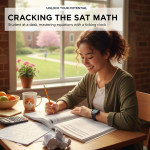Why You Might Take Both Tests — and Why That Changes Your Prep
If you’re thinking about taking both the Digital SAT and the ACT, first: smart move. Many students do this because different colleges accept either test, certain scholarships or programs prefer one score over another, or you want every possible chance to show your strengths. But taking both tests means you can’t treat prep like a one-test sprint. Instead, you’ll need a plan that balances overlap, avoids burnout, and gives you a real advantage on test day.
Two tests, one student: what that actually looks like
At a glance, SAT and ACT content overlaps heavily: both test reading comprehension, grammar-based writing skills, algebra and problem solving, and some data interpretation. But the shape of the tasks — timing, passage length, question style, and the presence of a discrete science section on the ACT — changes the skills you’ll need to practice. The good news is most of your content study (vocab through context, algebra, geometry basics, reading strategies) helps both tests. The challenge is managing the differences so you don’t confuse strategies under time pressure.
Start With an Honest Baseline: Diagnostic Tests
Before you plan anything, take a realistic, timed diagnostic for both the Digital SAT and the ACT. Do them on the devices and under the conditions that match the real test as closely as possible. This will give you:
- A snapshot of where you stand on each test
- A feel for time pressure differences
- Clear data to guide which test might be more efficient for you to prioritize
Don’t be shocked by the results — they’re information, not fate. If you’re a junior with limited prep time, a diagnostic will instantly reveal whether you should focus on one test first or split time evenly.
How to interpret the diagnostics
- Higher SAT than ACT by a comfortable margin: Consider prioritizing the SAT and using a lean maintenance routine for the ACT.
- Higher ACT than SAT: Reverse the approach.
- Very similar scores: You have latitude to pick one to sharpen more deeply or to alternate weeks for focused work on each test.
Make a Realistic Timeline: Backward Planning from Test Dates
Once you know your current levels, pick your target test dates and build backward. If you plan to take both once, stagger them by at least four to six weeks so the final push for each test is specific and focused. If you want to take both multiple times, alternate cycles so that practice for one doesn’t overwrite the other in the final two weeks before a sitting.
Sample timelines (choose the one that fits your school year)
Below are three sample timelines. Each assumes full-time school, extracurriculars, and the need for sustainable habits.
| Option | When to Start | Structure | When to Take Tests |
|---|---|---|---|
| Focused Sprint | 12 weeks before first test | 8 weeks SAT focus → 2 weeks switch → 2 weeks ACT review | SAT in week 12; ACT in week 18 |
| Balanced Alternation | 16 weeks before first test | Alternate 2-week blocks: SAT / ACT / SAT / ACT | Both tests spaced 6–8 weeks apart |
| Long-Term, Low-Stress | 6 months before first test | Daily content that helps both + weekly test-specific drills | Multiple test dates across spring and fall |
Pick the structure that works with your school and life demands. The sprint is intense but effective if deadlines are close. Balanced alternation stops you from losing ground on either test. The long-term approach is best for steady improvement with minimal stress.
Design a Weekly Study Plan That Respects Overlap
Your weekly plan should have three pillars: shared content, test-specific drills, and full-length practice tests. Shared content is what gives the best return on time investment because it’s useful for both tests.
Weekly template (10–12 hours/week example)
- 3 hours — Content study (algebra, grammar, reading skills) that helps both tests
- 3 hours — Test-specific drills (timed ACT science passages or SAT’s digital module practice)
- 2 hours — Strategy work (timing strategies, guessing rules, calculator use policies)
- 2–4 hours — Weekly or biweekly full practice tests (alternate SAT/ACT)
Quality beats quantity. Two focused hours on high-value content (like linked algebra and data-analysis questions) will help more than six distracted hours.
Study Strategies That Work For Both Tests
There’s a sweet spot of study strategies that make both SAT and ACT prep more efficient. Use these to build momentum.
1. Master the language of test questions
Questions are written in a predictable way. Practice extracting what the question asks before diving into the answer choices. This reduces careless mistakes on both tests.
2. Active practice beats passive reading
Solve problems, then explain your reasoning out loud or write it down. Teaching a concept — even to an imaginary student — cements it far better than rereading notes.
3. Timed mini-drills
Do short, timed drills that mimic the rhythm of each test. For the SAT, drills focusing on short passages and modular timing will help. For the ACT, practice longer reading passages and the dedicated science section under test timing.
4. Error logs and pattern hunting
Create a running log of mistakes. Categorize them (careless error, content gap, timing, misread question). Over weeks you’ll see patterns to fix systematically.
Strategy Differences: What to Practice Separately
Even though content overlaps, these tactical differences matter. Train each one deliberately so they become automatic under pressure.
Reading
- SAT: Shorter passages and modular sections — practice quick passage mapping and one-question-at-a-time accuracy.
- ACT: Longer passages and clusters of questions — practice stamina, synthesis across paragraphs, and skimming for structure.
Math
- SAT: Familiarize with the built-in graphing tool and formula support. Practice entering numeric answers for the fill-in questions.
- ACT: Practice faster execution and efficient calculator use, because you have less time per question.
Science / Data interpretation
- SAT: Scientific reasoning appears across passages. Focus on interpreting charts and applying quantitative reasoning to passages.
- ACT: There’s a discrete science section. Practice quick data reading, identifying variables, and making inferences from experiments and graphs.
Make Full Tests Your Weekly North Star
At least every other week, take a full, timed practice test for one of the exams. Simulate conditions: device, breaks, no distractions. After each test, spend at least as much time reviewing answers as you did taking the test. That’s where the gains happen.
How to review a full test efficiently
- Score it like the real thing, then record section-level results.
- Pick the 10–12 most damaging errors and dig into the cause of each.
- Make a short correction set: 1–2 targeted drills to fix the root cause of repeat mistakes.
Sample 8-Week Plan for Students Taking Both Tests
This plan assumes you already did diagnostics and have moderate time. Substitute longer blocks if you have more weeks.
| Week | Focus | Key Activities |
|---|---|---|
| 1 | Baseline & Content | Take digital SAT & ACT diagnostic; set target scores; begin algebra/reading units |
| 2 | SAT Focus | SAT timed modules practice; math drills using graphing tools; error log creation |
| 3 | ACT Focus | ACT reading & science strategy drills; timed math sections; practice longer passages |
| 4 | Mixed Review + Practice Test | Full SAT practice test; deep review; targeted follow-ups |
| 5 | Content Gaps | Target weakest topics from diagnostics; daily focused practice (30–45 min) |
| 6 | ACT Polishing | Full ACT practice test; practice pacing and science passage rotation |
| 7 | Timing & Strategy | Short timed drills; refine guessing and skipping strategy; practice section-specific timing |
| 8 | Final Review | Light content review; mental prep; test-day logistics check; rest before test |
How to Use Resources Without Getting Overwhelmed
There’s a dizzying number of prep materials out there. Keep your toolkit lean: one official practice resource for each test, a high-quality question bank, and 1–1 help if you need it. Personalized tutoring (for example, Sparkl’s personalized tutoring) can slot into this approach naturally: a tutor or coaching program can give you a tailored study plan, 1-on-1 guidance on your recurring errors, and AI-driven insights that point out patterns faster than you can alone.
When to invest in tutoring or a study coach
- If your diagnostics show stubborn, repeat mistakes despite practice
- If you have limited time and want to maximize efficiency
- If you benefit from accountability and structured plans
A good tutor won’t just teach content — they’ll reveal your testing patterns, adapt your plan as you improve, and help you build calm into test day. If you choose personalized tutoring, look for programs that emphasize tailored study plans and give specific, action-oriented feedback rather than generic tips.
Mental Preparation, Test Day Habits, and Logistics
Good scores aren’t just knowledge — they’re habits. Here’s how to guard your performance in the weeks and days before each test.
Sleep, nutrition, and pacing
- Sleep: In the two weeks before each test, prioritize consistent sleep. Avoid cramming the night before — you’ll trade raw stamina for temporary recall that often vanishes under pressure.
- Nutrition: Low-glycemic breakfasts (protein + complex carbs) and hydration support mental stamina. Pack snacks for between tests if you have back-to-back days.
- Pace: On the test, use a simple pacing plan — know how many questions per chunk you want to hit and where you’ll skip if time’s tight.
Device and tech checks for the Digital SAT
With the Digital SAT, check your testing device well in advance. Complete any required downloads, verify battery life, and have a backup plan if you’re using a school-issued device. If you’re also taking the ACT in its paper form, practice toggling between device-based and paper strategies so the change isn’t jarring.
When to Stop Studying Before Each Test
Know when to taper. For most students, the last 48–72 hours before a test should be low-intensity: light review of high-yield notes, a few gentle drills to keep your mind sharp, and plenty of sleep. If you have two tests close together, plan a small buffer day between them for physical and mental recovery.
Example: A Student Who Improved by 120 Points Without Burning Out
Meet Maya (a composite example). In January she took diagnostics: SAT 1100, ACT 22. Her school schedule was busy; she had 14 weeks to prepare for both. She chose a focused sprint — SAT first because her target colleges preferred the digital SAT windowed application. Her plan included:
- Weekly 2-hour tutoring sessions focused on algebraic problem-solving and passage analysis (tailored guidance via her tutor helped close content gaps quickly).
- Alternate-week full practice tests with rigorous review and error logs.
- 10-minute daily drills for vocab-in-context and data interpretation that helped both tests.
She took the SAT in week 12 and the ACT in week 18. The structured review and strategic tutoring improved her SAT by 80 points and her ACT’s composite equivalent by 120 points overall across both tests. The key was a consistent, personalized plan that treated both tests as related but distinct challenges.
Common Traps Students Fall Into — and How to Avoid Them
- Trying to memorize rather than understand: Both tests reward comprehension and strategy more than memorized tricks.
- Ignoring timed practice: Speed and accuracy under time pressure require deliberate training.
- Switching strategies too often: Pick approaches that work (e.g., how you annotate passages or when you skip questions) and keep them consistent across practice sessions so they become second nature.
- Not reviewing mistakes thoroughly: Treat every mistake as an experiment that reveals something about your process.
Practical Tools to Track Progress
Create a simple study dashboard: weekly hours, practice test scores, top three recurring error types, and target mini-goals for the next week. Here’s a compact, reproducible format you can use in a notebook or spreadsheet.
| Metric | Current | Target (4 weeks) | Action Steps |
|---|---|---|---|
| SAT composite | 1100 | 1200 | 8 SAT module practices/week + 1 tutor session |
| ACT composite | 22 | 24 | 2 ACT full sections/week + science drills |
| Weekly study hours | 6 | 10–12 | Block 60–90 min sessions after school |
| Top error types | Algebra mistakes; careless reading | Reduce repeat errors by 50% | Targeted error logs + corrective drills |
How to Decide Which Test to Send to Colleges
After your test dates, compare your best scores in the context of your college list. If one test consistently outperforms the other for you, it’s reasonable to send the stronger score. If you have comparable scores, consider the test that highlights your strengths (some students’ reading is stronger on SAT-style passages; others prefer ACT’s science-driven reasoning). Personalized tutoring can help you interpret these results and decide strategically which scores to submit.
Final Tips — Less Obvious, But Powerful
- Practice transitions: The feeling of moving between device-based testing (Digital SAT) and paper (ACT) is real. Run a short routine where you switch formats quickly so the transition is routine, not jarring.
- Keep a short pre-test ritual: a 5–10 minute warm-up of two problems you can solve reliably builds confidence before a real test or practice exam.
- Use the break strategically: Rest your eyes, hydrate, and do a one-minute calm breathing exercise to reset attention.
- Maintain perspective: Admissions decisions are holistic. Strong scores help, but colleges look at more than just one number.
When Personalized Help Makes the Biggest Difference
Self-study can take you a long way, but a targeted, personalized coach can accelerate improvements by cutting through inefficiency. A tutor who builds tailored study plans, offers 1-on-1 guidance on weak topics, and uses data-driven insights to prioritize work can convert hours of unfocused practice into measurable score gains. If you’re juggling both SAT and ACT prep, the right tutor can help you decide how to split your time, which strategies to lock in, and how to peak at the right moment.
Programs like Sparkl’s personalized tutoring emphasize these strengths: individualized plans, expert tutors who understand both tests’ nuances, and AI-driven insights that reveal patterns you might miss. When that kind of help fits into your schedule — even a few sessions spread across your prep timeline — it often yields outsized returns because it makes your practice smarter, not just longer.
Wrapping Up: Your Next 7-Day Action Plan
To turn all this advice into something usable, here’s a compact 7-day plan you can start with right away.
- Day 1: Take or re-review your SAT and ACT diagnostic results. Identify the top three weaknesses for each test.
- Day 2: Build a weekly schedule that includes 3 focused content blocks and 2 test-specific drill sessions.
- Day 3: Start an error log and categorize the first 10 mistakes you see in practice.
- Day 4: Do a timed SAT module and an ACT timed section; review both immediately.
- Day 5: Work on a stubborn content gap for 60 minutes (with guided problems).
- Day 6: Light review and a 20-minute pacing drill for reading sections.
- Day 7: Rest or do a relaxed, confidence-building warm-up. Reflect and adjust next week’s plan.
One week of consistent, focused effort creates momentum. Keep the process sustainable, track your progress, and be willing to tweak your plan as you learn more about how you perform under pressure. With steady strategy, smart practice, and targeted support when you need it, taking both the Digital SAT and ACT becomes less about doubling work and more about maximizing opportunity.
Final Thought
Balancing SAT and ACT prep is a challenge, but it’s also an opportunity to deepen your skills in ways that pay off beyond admissions — clearer critical thinking, stronger time management, and greater test confidence. Build a plan that respects your life, lean into shared study wins, practice each test’s unique moves, and don’t hesitate to get personalized help when the path gets fuzzy. You’ve got this — and the right plan will make sure the effort you put in shows up where it matters most.













No Comments
Leave a comment Cancel